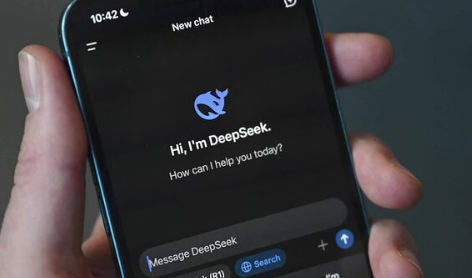
After losing billions with hedge funds, Liang Wenfeng created Deepseek, the startup that challenges OpenAi and shook the global market with its artificial intelligence
Three years ago, Liang Wenfeng’s quantitative funds company apologized to investors for loss during a turbulent period in the Chinese stock market. It was an unexpected turnaround for Zhejiang High-Flyer Asset Management, which used artificial intelligence to select actions and had grown rapidly until it became one of China’s largest quantitative funds.
While the company faced this crisis and saw its assets shrink in more than a third of the $ 12 billion peak, Liang worked behind the scenes to launch his new AI startup, DeepSeek.
Now DeepSeek threatens to transform the Global Chain of Artificial Intelligence Supplies and challenge US leadership into a cutting -edge technology. The sudden success of the company of only 20 months and its AI model caused a collapse in US and European bags, eliminating nearly $ 1 trillion of the giant market value like Nvidia Corp.
Liang’s feat impressed the technology industry. Although he has never studied or worked outside China, he has shown that local engineers, with limited access to advanced semiconductors and modest financial resources, can match – and even overcome – the best in the world.
Deepseek vs. OpenAi and the Race for AI Supremacy
“Any country could develop this type of project if it could gather the necessary talent,” said Shuman Ghosmajumder, CEO of the AI Reken startup based in San Francisco.
The question that now worries investors, companies and governments is whether the innovation in AI really requires hundreds of billions of dollars in investments. In addition, the debate on the effectiveness of export controls is growing to contain Chinese competition.
Liang is often compared to OpenAi’s founder Sam Altman, but maintains a discreet profile and rarely grants interviews. “Openai is not a god and can not always be in the forefront,” he told 36kr in July 2024.
He also said that more investment does not always result in more innovation. According to Liang, the problem of Chinese companies is not the lack of technology, but the insecurity and difficulty in organizing talents to effectively generate innovation.
An unusual trajectory
Born in 1985 in the city of Zhanjiang, a poor region of the province of Guangdong, Liang is the son of a primary teacher. He studied electronic engineering at the University of Zhejiang, one of the most prestigious in China, where he also got a master’s degree in Information and Communication Engineering.
High-Flyer, founded by Liang and two former university colleagues, was an exception in China’s quantitative funds market. Unlike other Chinese quantitative funds managers, none of them had experience abroad or traditional financial institutions.
The trio experienced several investment strategies before adopting, in 2015, a systematic model to implement their negotiation ideas. In 2016, they began testing machine learning and, in 2018, integrated this technology into the company’s portfolio.
Artificial intelligence has allowed High-Flyer to innovate and develop a multi-strategy investment model, accumulating returns from different sources. Its main fund, linked to the CSI 500 index, exceeded 120 percentage points in the three years before 2020.
With this success, the company’s assets exceeded 90 billion yuans ($ 12.5 billion) in 2021. However, that year, the company suffered record losses when its IA failed to predict sudden market oscillations.
In December 2021, High-Flyer admitted that its AI made mistakes and apologized to investors. The company stopped accepting new contributions, reduced its assets under management and adjusted its strategies. In March 2022, he warned more sensitive clients to volatility to withdraw their money – an unusual attitude in the sector.
Since then, High-Flyer has abandoned high and low betting strategies and has focused on “long-only” investments, ie only in actions expecting to appreciate. Its assets fell to about 60 billion yuans ($ 8.3 billion).
DeepSeek came up with the support of High-Flyer
Deepseek survey was funded by High-Flyer’s R&D budget. The quantitative funds company also provided computational infrastructure, as it had 10,000 NVIDIA GPUs before US restrictions to export these advanced chips.
Liang recruited the talents exclusively from China, attracting recent graduates of elite universities, doctoral trainees and even scientific olympics medalists.
“He is a nerd, but in this context this is not negative,” said Zihan Wang, a doctoral student at Northwestern University, who interned at Deepseek in 2024. According to him, Liang led experiments personally, and the startup operated as one Research Laboratory.
Even in the face of US restrictions, Deepseek continued to launch models of increasingly advanced AI. On January 20, 2025, the same day Donald Trump took over the US presidency, the company launched DeepSek-R1, its advanced AI reasoning model.
Shortly before, that Monday, Liang participated in a closed symposium in Beijing with Chinese Prime Minister Li Qiang. The event brought together experts to discuss a government work report. Images of the meeting show Li listening carefully as Liang speaks.
Global impact and future challenges
Deepseek-R1 was made available for free as an open source, allowing developers around the world to use and modify. This movement signals the company’s intention to collaborate with the Global AI community.
Experts point out that Liang stands out among Chinese entrepreneurs for prioritizing innovation and pursuit of General Artificial Intelligence (AGI) instead of immediate profit.
DeepSeek can turn Liang into a billionaire. It holds 51% of High-Flyer, a share valued at $ 71 million. If your startup reaches the value of OpenAi – estimated at $ 150 billion – your fortune can trigger.
Still, there are doubts about DeepSeek’s ability to scale its infrastructure to meet the growing global demand. Moreover, the way the company will deal with sensitive themes, such as the massacre of the Heavenly Peace Square and questions about Xi Jinping, remains unknown.
Another challenge is hardware limitation. Some analysts believe that DeepSeek needs at least 50,000 Nvidia H100 chips to operate on a global scale. For comparison, the goal (owner of Facebook) uses about 600,000 of these chips.
Despite the uncertainties, DeepSeek has already forced a revaluation of the AI race. “The dispute will not be won by those who create the most sophisticated model, but by those who integrate AI in business in order to generate real economic value,” said Mike Capone, CEO of the Qlik data analysis platform.
With information from Bloomberg*
Source: https://www.ocafezinho.com/2025/01/29/genio-chines-criou-a-deepseek-apos-crise-dos-fundos-de-hedge/

